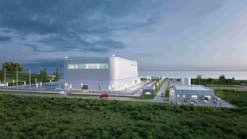Boston University going Geothermal to supply new Center for Computing and Data Sciences
The new campus for Boston University's Center for Computing and Data Sciences is being built as a net carbon-free facility with geothermal energy supplying nearly all of its heating and cooling, according to reports.
Contractors are boring holes and fixing pipes so the campus can be supplied with about 300 tons of heating and cooling capacity. The installed heat pumps could deliver about 90 percent of the facility's needs.
The BU Center for Computing and Data Sciences project is due to be completed this year. KPMB was the architectual contractor for the new build.
"The center will be state of the art in every way: striking architecture, advanced resources, environmental sensitivity, and interior spaces designed to facilitate collaboration," reads the university's website about the CCDS. "Rising above Central Campus, the 19-story structure will house our mathematics, statistics, and computer science programs, as well as the renowned Rafik B. Hariri Institute for Computing and Computational Science & Engineering."
Subscribe to our free, tri-weekly Email Newsletter for more
A recent study involving BU, Harvard, Oregon State researchers and the nonprofit Home Energy Efficiency Team found that building energy consumption is best met by technologies such as ground source heat pumps. Electrified heating may be less efficient and unable to meet cold winter challenges, the report reads.
Another of Massachusetts’ higher education facilities, Smith College, broke ground earlier this year on a new geothermal campus project. The school says the geothermal system will cut its carbon emissions by 90 percent and help the campus go carbon-neutral by 2030.
The Smith College geothermal complex will replace the school’s aging, fossil-fueled steam heating system.
Federal statistics indicate that buildings consume close to 40 percent of total energy in the U.S. and emit close to 14 percent of greenhouse gas emissions nationally, according to reports.
-- -- --
(Rod Walton, senior editor for EnergyTech, is a 14-year veteran of covering the energy industry both as a newspaper and trade journalist. He can be reached at [email protected]).





